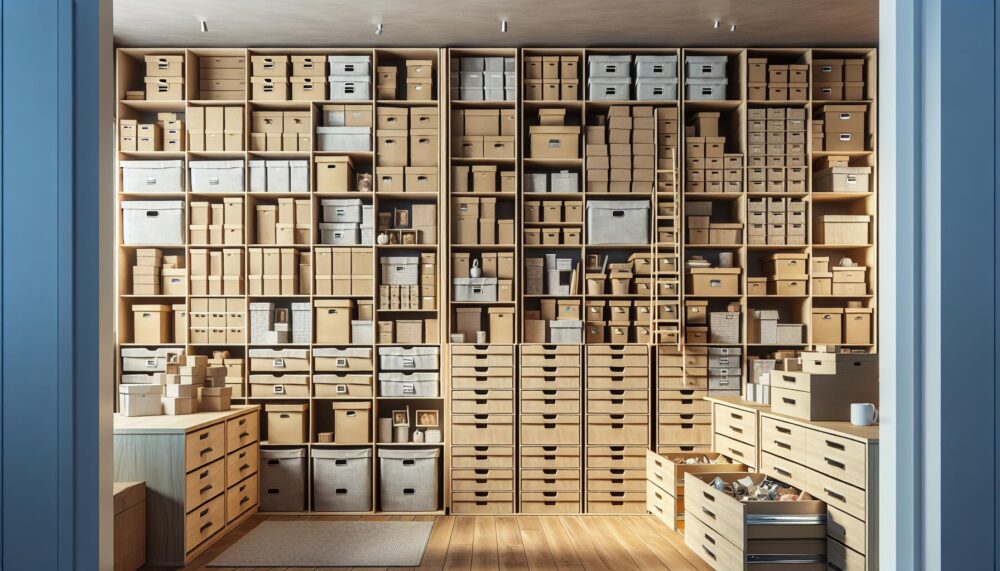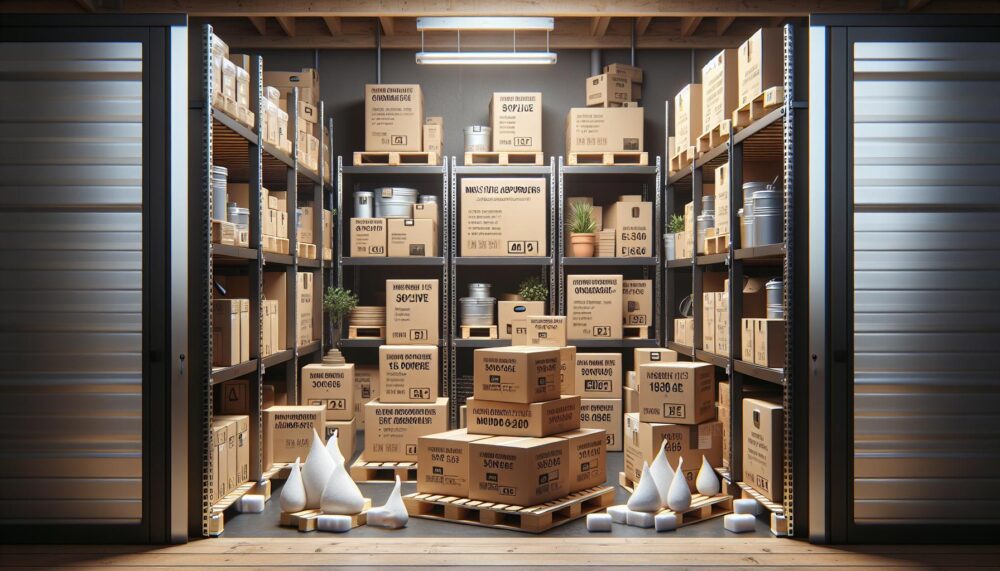June 11 2024
Are you a student struggling to find space for all your belongings? With limited dorm rooms and shared living spaces, it’s no surprise that many students turn to self-storage solutions. But how do you ensure your items stay safe and accessible?
Imagine packing up your things for the summer, only to find them damaged or missing when you return. It’s crucial to choose the right storage unit and take necessary precautions. This article will guide you through the best practices for using self-storage, from selecting the right size unit to ensuring security and protection from environmental hazards.
Key Takeaways
- Select the Right Unit Size: Choose a storage unit that matches the volume and type of items you need to store, from small 10-25 sq ft units for clothes and bicycles to larger 50+ sq ft units for apartment contents.
- Prioritise Location and Accessibility: Opt for a storage facility near your college campus with convenient access hours and entry points to save time and effort.
- Ensure Robust Security: Look for facilities with 24/7 CCTV coverage, gated access, individual unit alarms, and available insurance options to keep your belongings safe.
- Effective Packing and Organising: Use quality packing materials, categorise and label boxes, and use vertical space efficiently to keep your items safe and easily accessible.
- Maintain and Safeguard Your Unit: Regularly check your unit for moisture, keep it clean, and secure valuable items with robust locks and insurance to prevent damage and theft.
- Manage Costs Efficiently: Take advantage of off-peak rental rates, student discounts, and consider sharing a unit with peers to reduce storage expenses.
Choosing the Right Self Storage Unit As A Student
Selecting an appropriate self-storage unit can significantly ease the stress of moving belongings during term breaks. Follow these guidelines to ensure your storage experience is hassle-free and efficient.
Size and Capacity Required
Determine the storage unit size based on the volume and type of items you’re planning to store. Most self-storage companies offer units ranging from small 10 sq ft spaces, similar to a telephone box, to much larger options. For instance:
- Small Units (10-25 sq ft): Ideal for items like winter clothes, textbooks, or a bicycle.
- Medium Units (25-50 sq ft): Suitable for larger items such as small furniture, a TV, or multiple boxes.
- Large Units (50+ sq ft): Best for storing the contents of a small apartment, including furniture and appliances.
Here’s a quick reference table to help you select the right size:
| Unit Size | Suitable For |
|---|---|
| 10-25 sq ft | Clothes, books, bicycles |
| 25-50 sq ft | Small furniture, TVs, multiple boxes |
| 50+ sq ft | Apartment contents, larger pieces of furniture |
Location and Accessibility
Choosing a storage facility near your college campus can save you time and effort, especially during busy periods. When considering location:
- Proximity: Select a unit close to your accommodation or frequent routes for convenience.
- Access Hours: Check if the facility offers 24/7 access or has specific hours. If you need frequent access, choose one with flexible hours.
- Entry Access: Opt for a unit closer to the entrance if you’re moving heavy or numerous items frequently.
Security Measures
Ensure your belongings are safe by selecting a facility with robust security features. Important security aspects include:
- Surveillance Cameras: Look for facilities with 24/7 CCTV coverage to monitor activity.
- Gated Access: Choose storage units that require a code or keycard entry to prevent unauthorised access.
- Unit Alarms: Some facilities offer individual unit alarm systems for added security.
- Insurance Options: Consider insurance plans offered by the storage provider to cover any potential damages or losses.
By choosing the right self-storage unit, you can make your college life more organised and stress-free. Prioritise size, location, and security to ensure a seamless experience.
Best Practices for Packing and Organising
Effective Packing Techniques
Your packing methods significantly impact how safely and neatly your items remain stored. Start by gathering quality packing materials, such as sturdy boxes, bubble wrap, and packing tape. Durable boxes resist damage better, protecting your items from getting crushed.
- Categorise Items: Group similar items together. For example, store kitchenware in one box and books in another. This simplifies unpacking.
- Use Bubble Wrap: Wrap fragile items in bubble wrap. This minimises the risk of breakage during transit and storage.
- Fill Empty Spaces: Use packing peanuts or crumpled paper to fill gaps inside boxes. This prevents items from shifting.
- Label Boxes Clearly: Write a brief description of the box contents and the room it belongs to. For instance, label a box “Kitchen – Glassware” to easily locate items later.
- Stack Boxes Strategically: Place heavier boxes at the bottom and lighter ones on top. This maintains structural integrity and prevents crush damage.
Organising Items for Easy Access
Organising your storage unit logically ensures you can quickly find and retrieve items when needed. Start by planning the layout based on access frequency.
- Prioritise High-Use Items: Place items you’ll need frequently near the front of the unit. For example, keep seasonal clothing or study materials easily accessible.
- Create an Inventory List: Document every item in your storage unit. Use a spreadsheet or a notepad to list items by category and box number. This saves time when searching for specific belongings.
- Label All Boxes: Clearly label each box on multiple sides. Include detailed descriptions to avoid opening multiple boxes to find an item.
- Utilise Vertical Space: Stack boxes and other items vertically to maximise storage space. Use sturdy shelving units for additional organisation.
- Leave Aisles: Maintain clear pathways within your storage unit. This allows easy movement and access to all stored items.
Employ these practices to ensure your student self-storage experience is organised and efficient. By investing time in effective packing and organising, you can avoid common storage pitfalls and safeguard your belongings.
Maximising the Use of Space

Arranging Items for Optimal Space Usage
Organising items efficiently makes a significant difference in the space you utilise. Begin by grouping similar items together. For example, place all kitchen utensils in one area and electronics in another. This categorisation helps in finding items quickly when you need them.
Store less frequently used items at the back. If you regularly need access to certain belongings, position them near the front of your storage unit. This strategic placing saves time and effort.
Consider using drawers and cabinets for small items. Place these pieces of furniture towards the back of your unit and fill them with smaller items like stationery or toiletries.
Using Vertical Space
Stacking boxes vertically maximises your unit’s height, making the most of available space. Always place heavier boxes at the bottom to maintain stability. Lighter boxes should go on top to prevent any damage to fragile items.
Shelves can be a game-changer. Install shelving units to create multiple layers of storage. Use these shelves to store smaller boxes or items that you need to access frequently.
Leverage the empty spaces within furniture. For example, use the inside of a wardrobe to hang clothing items or store shoes. This approach frees up additional space in your unit.
By implementing these strategies, you can optimise your storage unit, making it easier to find your belongings and maintaining order.
Safety and Maintenance in Self Storage

Regular Maintenance Tips
Maintaining your self-storage unit is essential for preserving your belongings. First, check your unit periodically to ensure no signs of moisture or mould. Moisture can cause significant damage to items like books, clothes, and electronics. Using moisture absorbers or dehumidifiers can help control humidity levels.
Secondly, keep your storage unit clean. Sweep the unit regularly to prevent dust and debris buildup, which can attract pests. Place items off the ground using pallets or shelves to enhance airflow and further deter pests.
Also, inspect your items for damage each time you visit. Catching issues early can prevent more significant problems later. When storing items long-term, ensure they are properly packed and sealed. Use quality boxes rather than plastic bags to avoid moisture accumulation and mildew.
Security and Safety Best Practices
Ensuring the security of your stored items is paramount. Choose a storage facility with robust security measures. Look for features like video surveillance, gated access, and advanced lock systems. These features significantly reduce the risk of theft.
Investing in an insurance policy for your stored items is also wise. Many storage facilities offer insurance, but you can also explore third-party options. This gives you peace of mind knowing your items are protected against unforeseen events like theft or fire.
Besides, consider labelling your boxes clearly. This practice not only helps with organisation but also enables easier identification of valuable items. Store expensive or sentimental items towards the back of the unit for added security.
To enhance fire safety, avoid storing flammable items like petrol, paint, or gas canisters. Lock your unit securely and ensure the facility has working fire alarms and sprinklers.
By adhering to these maintenance and security practices, you ensure your belongings remain safe and well-preserved throughout your storage period.
Cost Management for Storage
Cost management is crucial for students who often operate on tight budgets. Implementing best practices can help you make the most of your storage solution without very costly.
Budget-Friendly Storage Solutions
Choosing an affordable storage solution is key. Look for storage facilities that offer various unit sizes. A smaller unit might be sufficient if you only need to store a few items. Most self-storage companies offer units ranging from around 10 sq ft (about the size of a telephone box) up to larger sizes.
- Off-Peak Rental Rates: Certain times of the year may have lower demand for storage units. Renting during off-peak seasons can result in cheaper rates.
- Student Discounts: Many facilities provide discounts for students. Enquire about any potential savings based on your student status.
- Long-Term Rentals: Some storage companies offer discounted rates for long-term rentals. Considering a longer rental period might save money in the long run.
- Avoid Over-Insuring: Ensure that your insurance coverage meets but does not exceed your needs. Various plans range from £2,000 to £25,000 of coverage per unit, so choose one that fits your requirements.
Sharing Storage Solutions with Peers
Sharing a storage unit with peers can cut costs significantly. Collaborate with roommates or friends to share expenses and space efficiently.
- Shared Costs: Splitting the cost of a storage unit between multiple people reduces the financial burden on everyone involved.
- Collective Utilisation: Coordinate with your peers to store shared items, like sports equipment or seasonal clothing, together. This maximises the use of the storage space.
- Clear Agreements: Establish clear agreements on payment contributions, access, and responsibilities. This ensures smooth management and avoids misunderstandings.
By implementing these strategies, you can manage your storage costs effectively, making the most of your resources without sacrificing quality or security.
Conclusion
Exploring the world of self-storage as a student doesn’t have to be daunting. By carefully selecting a storage unit that offers both safety and accessibility, you can ensure your belongings are well-protected. Managing costs through strategies like off-peak rental rates and sharing units with peers can make storage more affordable. Remember to consider long-term rentals and student discounts to further reduce expenses. With these best practices, you’ll be well-equipped to handle your storage needs efficiently and economically.
Frequently Asked Questions
How do I choose the right storage unit for my needs?
Consider the size of the unit based on the quantity and dimensions of your belongings. Ensure the facility offers safety features like CCTV and secure access. Check accessibility to ensure it’s convenient for regular visits. Compare prices, read reviews, and consider factors like climate control if storing sensitive items.
How can students manage storage costs effectively?
Students can reduce costs by renting during off-peak seasons, exploring student discounts, and opting for long-term rentals. Sharing storage units with friends can also cut down expenses. Avoid over-insurance by ensuring coverage aligns with the actual value of stored items.
What are budget-friendly storage options for students?
Look for facilities offering student discounts, off-peak rental rates, and special promotions. Consider sharing a unit with peers to split costs. Long-term rentals often come with reduced monthly rates, making them economical for extended storage needs.
How can sharing a storage unit help save costs?
Sharing a storage unit allows students to split the rental costs, making it more affordable. It also promotes efficient use of space as items from multiple students are combined in one unit. Ensure to choose the right size and agree on a shared schedule for accessing the unit.
Why is it important for students to choose the right storage unit?
Selecting an appropriate storage unit ensures the safety and security of belongings. It aids in maintaining accessibility and managing costs effectively. A well-chosen unit reduces stress and helps students focus on their studies by providing peace of mind about their possessions.

OFFICE HOURS
M-F: 8:30am – 5:00pm
SAT: 8:30am – 2:00pm
ACCESS HOURS
7 Days Per Week
5:00am to 10:00pm